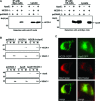Dual action of apolipoprotein E-interacting HCCR-1 oncoprotein and its implication for breast cancer and obesity
- PMID: 20196787
- PMCID: PMC4516534
- DOI: 10.1111/j.1582-4934.2009.00652.x
Dual action of apolipoprotein E-interacting HCCR-1 oncoprotein and its implication for breast cancer and obesity
Abstract
Obese women have an increased risk for post-menopausal breast cancer. The physiological mechanism by which obesity contributes to breast tumourigenesis is not understood. We previously showed that HCCR-1 oncogene contributes to breast tumourigenesis as a negative regulator of p53 and detection of HCCR-1 serological level was useful for the diagnosis of breast cancer(.) In this study, we found that the HCCR-1 level is elevated in breast cancer tissues and cell lines compared to normal breast tissues. We identified apolipoprotein E (ApoE) interacting with HCCR-1. Our data show that HCCR-1 inhibits anti-proliferative effect of ApoE, which was mediated by diminishing ApoE secretion of breast cancer cells. Finally, HCCR-1 induced the severe obesity in transgenic mice. Those obese mice showed severe hyperlipidaemia. In conclusion, our results suggest that HCCR-1 might play a role in the breast tumourigenesis while the overexpression of HCCR-1 induces the obesity probably by inhibiting the cholesterol-lowering effect of ApoE. Therefore, HCCR-1 seems to provide the molecular link between the obesity and the breast cancer risk.
Figures




Similar articles
-
Oncoprotein HCCR-1 expression in breast cancer is well correlated with known breast cancer prognostic factors including the HER2 overexpression, p53 mutation, and ER/PR status.BMC Cancer. 2009 Feb 11;9:51. doi: 10.1186/1471-2407-9-51. BMC Cancer. 2009. PMID: 19208263 Free PMC article.
-
The HCCR oncoprotein as a biomarker for human breast cancer.Clin Cancer Res. 2005 Nov 1;11(21):7700-8. doi: 10.1158/1078-0432.CCR-04-2609. Clin Cancer Res. 2005. PMID: 16278390
-
Transgenic mouse model for breast cancer: induction of breast cancer in novel oncogene HCCR-2 transgenic mice.Oncogene. 2004 Mar 11;23(10):1950-3. doi: 10.1038/sj.onc.1207356. Oncogene. 2004. PMID: 14691448
-
Novel oncogene HCCR: its diagnostic and therapeutic implications for cancer.Histol Histopathol. 2005 Jul;20(3):999-1003. doi: 10.14670/HH-20.999. Histol Histopathol. 2005. PMID: 15944950 Review.
-
The role of human cervical cancer oncogene in cancer progression.Int J Clin Exp Med. 2015 Jun 15;8(6):8363-8. eCollection 2015. Int J Clin Exp Med. 2015. PMID: 26309489 Free PMC article. Review.
Cited by
-
Macrophage-Derived Small Extracellular Vesicles in Multiple Diseases: Biogenesis, Function, and Therapeutic Applications.Front Cell Dev Biol. 2022 Jun 27;10:913110. doi: 10.3389/fcell.2022.913110. eCollection 2022. Front Cell Dev Biol. 2022. PMID: 35832790 Free PMC article. Review.
-
Association between apolipoprotein E genotype and cancer susceptibility: a meta-analysis.J Cancer Res Clin Oncol. 2014 Jul;140(7):1075-85. doi: 10.1007/s00432-014-1634-2. Epub 2014 Apr 5. J Cancer Res Clin Oncol. 2014. PMID: 24706182 Free PMC article.
-
Clinical implication of elevated human cervical cancer oncogene-1 expression in esophageal squamous cell carcinoma.J Histochem Cytochem. 2012 Jul;60(7):512-20. doi: 10.1369/0022155412444437. Epub 2012 Apr 17. J Histochem Cytochem. 2012. PMID: 22511601 Free PMC article.
-
Peroxisome proliferator activated receptor-α/hypoxia inducible factor-1α interplay sustains carbonic anhydrase IX and apoliprotein E expression in breast cancer stem cells.PLoS One. 2013;8(1):e54968. doi: 10.1371/journal.pone.0054968. Epub 2013 Jan 25. PLoS One. 2013. PMID: 23372804 Free PMC article.
-
Tumor-associated macrophages-derived exosomes promote the migration of gastric cancer cells by transfer of functional Apolipoprotein E.Cell Death Dis. 2018 Apr 1;9(4):434. doi: 10.1038/s41419-018-0465-5. Cell Death Dis. 2018. PMID: 29567987 Free PMC article.
References
-
- Ko J, Lee YH, Hwang SY, et al. Identification and differential expression of novel human cervical cancer oncogene HCCR-2 in human cancers and its involvement in p53 stabilization. Oncogene. 2003;22:4679–89. - PubMed
-
- Jung SS, Park HS, Lee IJ, et al. The HCCR oncoprotein as a biomarker for human breast cancer. Clin Can Res. 2005;11:7700–8. - PubMed
-
- Lamerz R, Stieber P, Fateh-Moghadam A. Serum marker combinations in human breast cancer (review) In Vivo. 1993;7:607–14. - PubMed
-
- Cho GW, Shin SM, Namkoong H, et al. The phosphatidylinositol 3-kinase/Akt pathway regulates the HCCR-1 oncogene expression. Gene. 2006;384:18–26. - PubMed
-
- Mahley RW. Apolipoprotein E: cholesterol transport protein with expanding role in cell biology. Science. 1988;240:622–30. - PubMed
Publication types
MeSH terms
Substances
LinkOut - more resources
Full Text Sources
Other Literature Sources
Medical
Molecular Biology Databases
Research Materials
Miscellaneous

